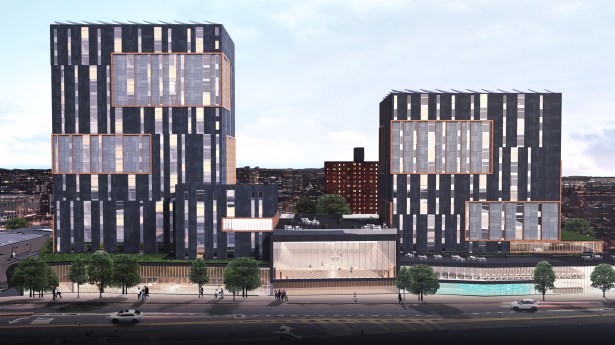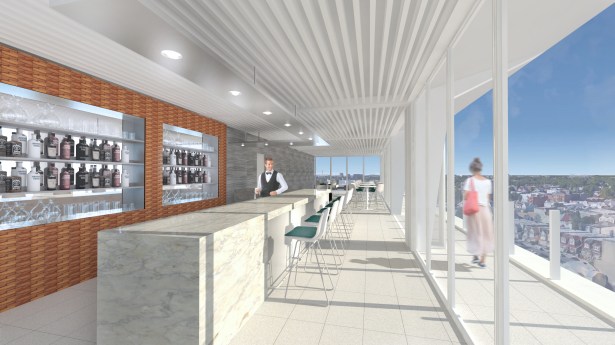Meet Hope Knight, the Woman at the Center of Jamaica’s Transformation
By Liam La Guerre February 15, 2017 9:00 am
reprints
Before Hope Knight became the president and chief executive officer of the nonprofit Greater Jamaica Development Corporation (GJDC) almost two years ago, she walked the neighborhood to get a sense of what it was like.
The East Harlem-born and raised Knight hadn’t actually been in eastern Queens in many years. She had been busy bouncing around the globe with various roles in numerous companies before landing as the chief operating officer of the Upper Manhattan Empowerment Zone (UMEZ) in 2002, an organization founded to revitalize deteriorating communities by injecting public funds to lure private investments.
She may have not been familiar with Downtown Jamaica (also known as DoJam for those looking to give the area a cute sobriquet), but Knight, now 52, saw elements that reminded her of one of UMEZ’s chief areas—Harlem—as she canvassed Jamaica Avenue, including a transportation hub, retail corridors, population diversity and historic places.
“I felt like Jamaica and the Downtown [area were] very similar, particularly Jamaica Avenue, to 125th Street in 2004,” Knight, who took over the GJDC role in May 2015, told Commercial Observer. “And [they were] approximately 10 years behind the development of that central corridor.”
Harlem now is buzzing with development, a thriving restaurant row and a host of retailers who have gotten in on the action, including Whole Foods Market, P.C. Richards & Son and H&M, thanks in part to Knight’s work with UMEZ. But since she started working in Jamaica the change, which had been set in motion decades prior, is starting to take effect. There are more than 3,666 new apartments and 2,194 hotel rooms planned for the Queens neighborhood, by GJDC’s count. And Knight is finding her role is to maintain the growth of Jamaica while still keeping it affordable.
“I knew that this community was positioned for continued revitalization, and I believe that I could employ some of the tools and actually that created change in Upper Manhattan,” Knight said.

Before she knew it, she was already advocating for the largest planned development in Jamaica.
GJDC selected developer BRP Companies for a project at 93-01 Sutphin Boulevard in 2012. GDJC owned the property, which was home to a Duane Reade and low-rise mixed-use buildings, since 2001 and agreed to sell it to BRP if the developer would build a large mixed-use project to spur growth in Jamaica. The sale closed in 2015 for $19.5 million.
BRP is currently constructing The Crossings at Jamaica Station at the site, a two-building, 669-unit residential complex with 40,000 square feet of retail and community space. The project will be targeting a mix of low- to middle-income families with its studios and one-, two- and three-bedrooms units. The development will encompass 737,000 square feet with one 25-story and one 14-story building. In January, BRP closed on about $324 million in financing from the city for the project. It is currently under construction and expected to be completed in 2019.
Although GJDC had been partnering on the site with BRP years prior to Knight’s arrival, the developer still needed her support when she came aboard to convince city agencies and politicians to get behind the project. And Knight delivered.
“Hope’s stewardship was consistent with our original plan,” said Meredith Marshall, a managing partner and co-founder of BRP. “Everything we needed—engagement with the [Metropolitan Transportation Authority], we needed to present to the borough president—we sought their advice and they were supportive along the way. She had to be really behind this to help push it forward.”
But Knight’s work as an advocate for new development is just beginning. GDJC owns five parking lots totaling 761,853 square feet in the area, and is planning to convert them into developments through partnerships with private developers.
Replacing parking lots makes the most sense; Jamaica already generally moves by public transportation. Aside from the E, the J, the (mythical) Z and F subway lines and the Long Island Rail Road, there is a bus hub with about two-dozen lines. (There are so many buses zigzagging around Jamaica that the official city bus map has a separate Jamaica inset.) Plus new developments generally have underground parking.
What Jamaica does need, Knight believes, is more housing to accommodate the burgeoning population. As a case in point, GDJC announced a partnership with developer Blumenfeld Development Group in 2013 for the development of two adjacent lots that the nonprofit owns on 168th Street into a retail complex of 160,000 square feet for big-box retailers and 550 parking spaces. After a local and political push for more housing, the developer announced amended plans in January 2015 so the project could include about 100,000 square feet of housing.
But in February 2016, the plans were quashed by both GJDC and Blumenfeld under Knight’s leadership.
Then in September 2016, GJDC released a revised request for proposals (RFP) seeking a development partner for just one of the open-air parking lots, located at 90-02 168th Street, for a whopping 497,500-square-foot project with 250 affordable apartments. Just 75,000 square feet has been designated for retail at the moment. And a developer has yet to be announced. (No word yet on when the remaining four lots will be offered up for sale.)
“I just think that the economy changes priorities, particularly on the residential side,” Knight said. “That project did not accommodate [enough] residential development, and now we are a point where residential development is clearly needed in this community.”
Knight has two fundamental passions that have guided her career choices: real estate and finance.
Like many Manhattanites, Knight grew up admiring the city’s buildings, many of which pioneered the current age of supertalls. She studied business at Marymount Manhattan College, from which she graduated in 1985 with a bachelor’s degree. (Today she is the chairwoman of the board of trustees of her alma mater.)
Upon graduation, she had a stint as an operations manager at Bloomingdale’s, then she transitioned to the city’s Department of General Services (today known as the Department of Citywide Administrative Services), where she was involved in the city’s acquisition and disposition of real estate. While working for the city, Knight earned an executive MBA from the University of Chicago and started working in financial services at Accenture Management Consulting in Manhattan. Then in 1997 she moved to Tokyo to work for Morgan Stanley as a vice president of e-commerce. (When asked if she could speak Japanese, she replied, “Sukoshi dake,” meaning, “only a little.”) She returned to the Big Apple in 2000 and continued working for the financial services firm until 2002.
Since she was traveling a lot for work meetings and had a son (who today is 15 years old), she decided to change her lifestyle and left Morgan Stanley. She found an opportunity to settle in New York City at UMEZ.
That job allowed her to combine her passions.
“I thought it would be interesting to work at the intersection of community development and finance,” she said.
UMEZ offers many small business owners in Harlem financing to help grow their businesses. It also gave funds to historic institutions such as the Apollo Theater and the Studio Museum in Harlem. As its COO, Knight played a big role in revitalizing Harlem before she left the position for GJDC in mid-2015.
That December, Mayor Bill de Blasio appointed Knight as one of the 13 members of the City Planning Commission (CPC). Thanks to regulations set by the city’s Conflict of Interest Board, Knight wouldn’t be able to weigh in on items pertaining Jamaica.
She would have to recuse herself if city planning was voting on another rezoning of the neighborhood, for example.
Besides conflict of interest issues, taking on the CPC role limits her free time.

“Almost all of the work and preparation needed for CPC review sessions and hearings is done on the weekends, so I am very busy working most weekends,” she said.
Jamaica Avenue and Harlem’s 125th Street may have seemed like a similar situation, but people had great expectations for her at GJDC after what Jamaica has been through. The area has been a deteriorating neighborhood since major retailers Macy’s, Gertz and May’s all left in the 1970s and 80s, along with financial institutions.
Carlisle Towery, the first president of the GJDC, spent more than four decades fighting for more public spending and infrastructure improvements in the area. He got it with more transportation: the extension of the subway lines to Parsons Boulevard and the AirTrain station, the latter which connects travelers to John F. Kennedy Airport.
Towery was also credited with being a major force behind the city’s decision to move York College, a City University of New York institution, to the neighborhood from sharing space at Queensborough Community College in Bayside, Queens.
And in 2007, the neighborhood got a much sought after rezoning in its Downtown, allowing investors to build bigger and more denser commercial and residential projects. The resolution was pushed by then Councilwoman Melinda Katz, who was chair of the land use committee, and is today the Queens borough president. The recession put plans on hold and Towery ended up retiring, but many projects are finally starting up again with Knight in the middle of it all.
“I think she is doing well,” said Towery, who served in an advisory role with GJDC until October 2016. “I have watched and read news about Jamaica, and applauded. The future for Jamaica looks very, very bright to me. And she’ll steer it very well. She is quite bright and entrepreneurial. I haven’t seen anything but progress since I left.”
“Hope has big shoes of her own,” said Melva Miller, the deputy Queens borough president who has worked with Knight on various initiatives. “She brings added value to the position. I think the time when Carlisle was the president of the GDJC there was a need that Carlisle was able to fill—convince the public sector that Jamaica was a place to invest. Hope‘s job and responsibility is about managing that growth. And I think she has done a very good job doing that.”
Public and private dollars are starting to roll into the area with the city’s Jamaica NOW Action Plan, which promises $153 million worth of funding for new developments and organizations to foster businesses and the arts. Thanks to that plan, there are now 18 WiFi kiosks in Downtown Jamaica, which allows free internet access throughout the neighborhood.
Also as part of the plan, the city announced last month the development of an old New York Police Department parking lot at 168th Street between Jamaica and Archer Avenues into a 450,000-square-foot mixed-use development with more than 350 affordable apartment and recreational and commercial spaces. The New York City Economic Development Corporation selected former Mets slugger Mo Vaughn’s Omni New York to develop the property.

In the private world, hotels, housing and retail are all under way. On the opposite site of the LIRR tracks from BRP mega-development, Able Management Group is constructing a 27-story Hilton Garden Inn with 225 hotel rooms at 93-47 Sutphin Boulevard. The Chetrit Group is converting the defunct Mary Immaculate Hospital at 150-13 89th Avenue into 324 apartments, according to New York City Department of Buildings records. And Flushing-based developer Jia Shu Xu is building a two-pack Marriott Courtyard, with 224 rooms, and Fairfield Inn & Suites, with 114 rooms, at 148-18 Archer Avenue. The project is expected to be completed this year.
Also, United American Land is erecting a 150,000-square-foot retail complex on Jamaica Avenue. The project is under construction and with a slated completion time of next year. United American Land has already signed a 35,000-square-foot lease with H&M and a 70,000-square-foot deal with Burlington Coat Factory. The development has retail space spanning the basement to the fourth floor.
“Jamaica Avenue is one of the great urban retail strips that is underdeveloped and retailers are looking for new markets,” said Albert Laboz, a principal at United American Land. “The TJ Maxxs and the H&Ms, the malls and suburbia is dead to them. There is no business. The urban market is new to them. [Jamaica] is something where the rents are not out of control and they can still make money. And that’s really the bottom line. There is no better underserved market in Queens than Jamaica.”
The commercial market is still in its infancy in Jamaica. But Empire State Development selected York College as the only school in Queens for Gov. Andrew Cuomo’s Startup-NY initiative, which offers 10 years of freedom from taxes to new and expanding businesses near eligible universities and colleges. Knight’s office is working with the school in the vetting and selection of those businesses, which would partner with the school. The first of those businesses will be announced shortly, Knight said.
With the dizzying amount of change occurring in Jamaica, one thing that worries many is the G word (i.e., gentrification). Knight is paying close attention to this, and it’s why she has advocated for housing that is for families with low to middle income.
“The parcels of land that we have sold for residential development have been specifically identified to develop mixed-income residential units,” Knight said. “We are looking at providing housing for a wide range of family incomes and accessibility.”
Big on Knight’s wish list for Jamaica is what may seem like a simple request: more sit-down restaurants. While Jamaica Avenue is bursting at the seams with national fast-food joints like McDonald’s, Wendy’s and Subway, and local ones, like Golden Crust, the highest-priced eatery is the Applebee’s on the second floor of 161-21 Jamaica Avenue.
Many in Jamaica leave for work (to places like Manhattan) in the morning, and when they come back in the evening, it’s to sleep. While there is shopping for necessities, groceries and clothes, the dearth of people staying in the area has resulted in slim restaurant options, according to Winick Realty Group’s Daniel DePasquale.
“The day-time population isn’t there. There are not a lot of offices, so at lunchtime there are not a lot of bodies there,” explained DePasquale, who is marketing spaces on Jamaica Avenue to national retailers. “No one is really going to go there for dinner time. Once the sun goes down on Jamaica Avenue, you don’t have much activity there.”
Knight is well aware of the problem and is advocating for more sit-down restaurants and entertainment options to various real estate professionals. Of note though is a rooftop bar at the Hilton Garden Inn that is under development.
“One of the things that is absent from the community is sort of a nightlife, because there isn’t that much residential density in the community, but that is going to change,” Knight said. “While these projects are being developed we also want to create some dining and entertainment infrastructure to support the new residents and existing ones.”
She added, “Three to five years from now, Jamaica will be a very different community in terms of scale and the availability of amenities here. And that is just going to continue to build.”
Additional reporting provided by Lauren Elkies Schram.


